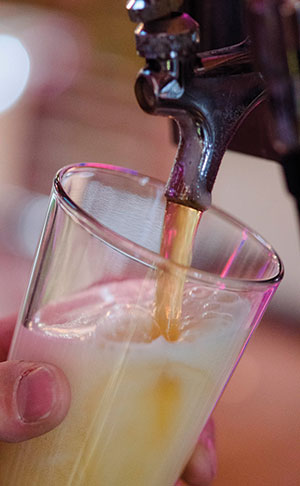
Left coast to eastern seaboard, microbreweries are not only crafting beautiful beers, they’re contributing to their communities and keeping their corner of the planet green. In Portland, Oregon, Roots Organic Brewery has grown its own organic produce to use in its pub grub, and through recycling and composting, the brewery has reduced its trash output by 98 percent. The brewery also uses 100 percent renewable energy from sources such as wind and solar. On the other side of the states, Brooklyn Brewery opts for energy from an upstate wind farm which reduces its annual carbon dioxide output by approximately 335,000 pounds.
In Arizona, during the thirsty southwestern summers, drinking a pint or two produced at the local microbrewery is a great idea for several reasons. A study by Northern Arizona University showed that the total economic impact of craft brewing on Arizona in 2011 was $278 million, and produced a total of 3,486 jobs. Arizona craft brewers are extremely positive about the future, with almost 70 percent planning to see growth in the coming year. Additionally, bending an elbow at a local microbrewery helps support a surprising array of small businesses in rural towns to big-city folk and creates jobs along the way. Tucson’s Nimbus Brewery finds a number of ways to keep their carbon footprint small. Managing partner Jim Counts has a background in electrical engineering and a keenness for conservation. “We do anything that makes sense to reduce our impact. We source our hops and grains from as close as possible to the brewery. Did you know it takes seven to nine gallons of water to make a gallon of beer?” he earnestly asks. “We recycle the water through the heat exchanger to brew the next batch of beer, which reduces our water usage to two gallons. Living in Arizona, we need to be careful with our consumption.”
The local flora and fauna also benefit from Nimbus’s green conscientiousness. “During the process of making beer, we have lots or organic waste, and the grains still have quite a bit of nutrients,” said head brewer Michael Gillis. “We donate all of our used grains–approximately 25 barrels a week–to Horse’n Around, a horse rescue center in Hereford. Our grain helps sustain around 100 horses.”
“Yeast can mess with the sewage systems, so instead of putting it down the drain, we add it to the grain given to the horses,” Jim added. “It’s a good nutrient.”
Leave Your Footprint Off My Garden, Bud
The number one contributor to a six-pack’s carbon output is the refrigeration it takes to keep the beer cool at stores. Transportation and shipment contribute to the beer’s carbon footprint, then barley and malt production, then the manufacture of glass bottles. Old Bisbee Brewing Company in Bisbee has deftly circumvented some of these issues by constructing a refrigeration system that’s completely enclosed, caskless, and bottleless. To achieve this, they dug up the street to transfer beer, underground, from the brew house to the holding tank and tap room area. “It’s an extremely efficient operation,” said brewer Vanessa Hunter.
Old Bisbee Brewing Company also recycled the history of its neighborhood. Once known as Brewer’s Gulch, the railroad brought cheap beer from St. Louis to thirsty copper,lead, and silver miners in the 1890s, effectively ending the local brewers’ livelihood. About a hundred years later, brewer Victor Winquist and former Boeing employee Dale Fountaine decided it was time to restore Brewer’s Gulch back to its heady glory days, including replicating the original façade. “Vic and Dale are visionaries. They’ve quite literally brought back the flavor of the old days,”Vanessa said.
“The Copper City Ale is made from a recipe found in the archives. Of course, a couple things had to change, but the beer has been kept as true to the original as possible.” So, could you say the beer itself has been recycled? “Well . . . in a manner of speaking,” was the cautious reply.
Microbrews and a study in “reuse, repurpose, recycle”-style architecture are served up at Barrio Brewery, located in the industrial section of Tucson. The building has seen a few iterations – a 1950s-era warehouse that owner Dennis Arnold believes was once a military surplus distributor, then a meat locker in the 1990s. The city wanted to tear it down, but Arnold saw the value in its rescue and rehabilitation.
“I’m kind of the Fred Sanford of microbreweries,” he said with a laugh. “There’s not much in the interior in there that wasn’t headed for a scrapyard. The walls are paneled with about forty different cuts of lumber. It was like a Tetris game because we took all this dimensional wood to piece together. We built the chandeliers from old car hoods. We took cast-off tile and created a pattern that’s not really a pattern in the bathrooms.”
Arnold also has plans to collect rainwater for landscaping, and reuse the process water to augment the bathroom plumbing. His knack for design comes from an aversion to waste. “I gather the materials, and get good guys to help. Barrio is ridiculously overbuilt – there may be an I-beam holding up a piece of tin – but the stuff was there. Whatever the junk gods give us, we turn into something. If it’s rusty, we like it.”
Hey! We’re Thirsty Up Here in Flagstaff!
With all the attention that thoughtful consumers are paying to greening up their lifestyles, it stands to reason that happy hour is getting the same environmentally conscious consideration. All over Arizona, breweries are coming up with inventive ways of giving good old beer and its environs a mindful makeover. In next month’s issue, northern Arizona quaffers will get equal bar time. In the meantime, it’s five o’clock somewhere






